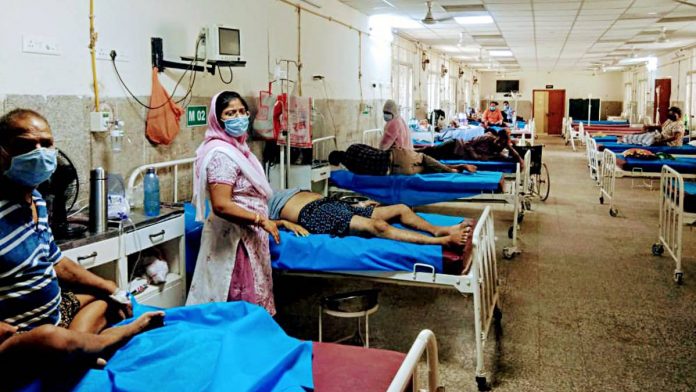
Coronavirus disease’s punishing second wave is receding in 19 Indian states and Union territories, some of which were its early epicenters, though some new hot spots have emerged in the south and north-east, where infections continue to surge.
Seven out of every ten Indians live in areas that are improving. Delhi, Chhattisgarh, Madhya Pradesh, Maharashtra, Bihar, and Uttar Pradesh are among the 19 states that were ravaged by the second wave, with most health-care systems overwhelmed by an influx of hospitalizations.
Even as the Covid-19 death toll continues to rise to alarming new highs, this trend provides a ray of hope. Despite a drop in new cases over the past week, daily deaths from the disease have remained above 4,000 in the last four days. To be sure, any change in case trajectory takes 14 days to reflect in daily deaths, as studies show that the median time between testing positive for Covid-19 and dying from it is 13.8 days.
Between May 7 and May 17, the average weekly positivity rate – the proportion of samples tested that return positive for Covid-19 – decreased in states and UTs that account for 69 percent of the country’s population, while 15 states and UTs accounting for the remaining 31 percent saw an increase, according to data.
Experts say the drop in positivity rates is largely due to the use of non-pharmaceutical interventions such as lockdowns, and that while cases are declining in most areas, the measures in place to control the spread of the disease must not be weakened just yet.
Areas in the country’s south and north-east, which fared better than the rest of the country during the worst of the second wave until April, are now seeing the highest increases in positivity rates. Andhra Pradesh, Tamil Nadu, and Karnataka, as well as north-eastern states like Meghalaya, Manipur, Sikkim, Tripura, and Arunachal Pradesh, were among the states with the highest increase in positive sentiment between May 7 and 17.
Importantly, this trend has sustained without daily tests going down in the majority of the country. In fact, the number of daily tests in the country have increased 5% between May 7 and May 17 – on average, a total of 1,813,242 samples were tested every day in the country in the past week, against 1,724,665 on May 7.
Regions that have made the most progress
Between May 7 and May 17, Delhi saw India’s largest change in average positivity rate in the last ten days, with a 14.3 percentage point drop (from 27.4 percent to 13.1 percent ). It was followed by Chhattisgarh, where the positivity rate fell 13.2 percentage points in the same time period, from 25.4 percent to 12.2 percent, and Haryana, where it fell 10.4 percentage points.
Goa is in fourth place in terms of most improved positivity rate (down 9.8 percentage points), but it still has the highest positivity rate in the country. More than a third (36.5 percent) of all samples tested in the state have tested positive for Covid-19 in the last week. Over the last two weeks, the coastal state has been in the news due to a severe shortage of hospital beds and medical oxygen, which has resulted in dozens of deaths. However, a drop in the region’s positivity rate provides some much-needed light at the end of the tunnel.
Jharkhand (down 8 percentage points from 15 percent to 7.0 percent ), Bihar (down 7.5 percentage points from 14.8 percent to 7.2 percent ), Madhya Pradesh (down 19.3 percent to 12 percent ), Maharashtra (down 6 percentage points from 21.7 percent to 15.6 percent ), and Uttar Pradesh (down 6 percentage points from 21.7 percent to 15.6 percent ) are among the other states where the positivity rate has improved significantly (down 6 points, from 11.9 percent to 5.9 percent ). Four of India’s five most populous states – Uttar Pradesh, Maharashtra, Bihar, and Madhya Pradesh – house more than 40% of the country’s population.
States and UTs where transmission is increasing
The majority of India’s south and northeast, on the other hand, is on the opposite end of the spectrum. Between May 7 and May 17, the positivity rate in Meghalaya increased by 6.7 percentage points, to 17.7 percent, the highest in India. It was followed by Andhra Pradesh, where the positivity rate increased by 5.8 percentage points from 18.7% to 24.4 percent, and Tamil Nadu (from 15.2 percent to 19.8 percent , up 4.7 percentage points). The positivity rate in Manipur (14.2 percent to 18.3 percent) and Karnataka (28.4 percent to 32.4 percent) both increased by 4.1 percentage points. In the past week, Sikkim and Karnataka had the second and third highest positivity rates – 32.6 percent and 32.4 percent, respectively.








